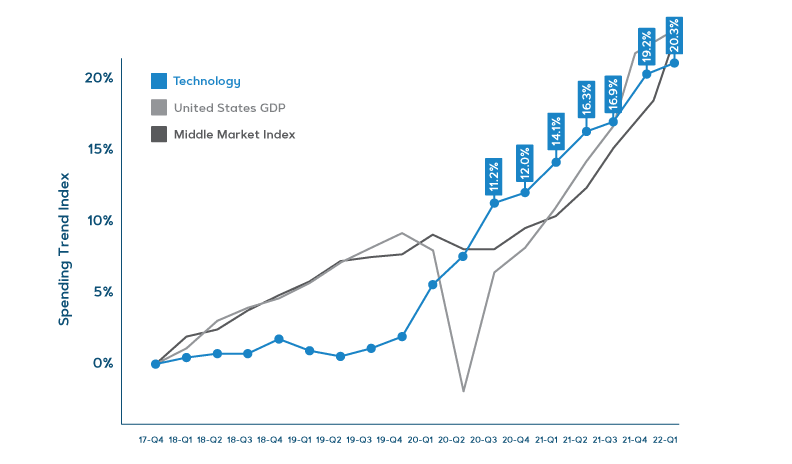We’re living in a complex business environment, adjusting from pandemic disruptions and dealing with newfound challenges, including a record-high labor shortage, supply chain disruptions, inflation, a war in Ukraine and a forecasted recession.
Based on our data and research, middle market companies are leaning into technology investments to help absorb the blows.
To understand how middle market companies are faring, we analyzed millions of financial transactions made between buyers and suppliers in our AvidPay Network during the first quarter of 2022.
We also conducted market research and surveyed more than 500 middle market finance professionals to understand how they feel about their business and where and why they are spending in response to the current economic challenges, especially when it comes to their finance department.
Among our findings, further detailed in our latest report, we noticed the continued investment in technology.
Our survey revealed middle market companies are investing in digital transformation, spending more on information technology (IT) and technology (22%) than they are on things like hiring, marketing and sales and operations.
Our AvidPay Network data reflects this trend. The average yearly technology spend increase since 2020 has been 7.4%. In comparison, the average yearly spend increase prior to that (2017-2020) was only 2.4%. In the past two years, the rate of spending has more than tripled.
Technology Spending Trends
Digital adoption is helping the middle market offset the costs of larger economic challenges by boosting efficiency and streamlining time and labor-intensive processes like routing and approving invoices and issuing payments. Specifically, it’s allowing them to do more with less.
They are feeling good about their commitment to modernization. In fact, 78% of middle market finance professionals surveyed feel the technology their organizations have adopted in the last two years will have a positive impact on business continuity.
“Middle market companies are proving their resilience with a positive outlook despite economic challenges plaguing business, including inflation, ongoing supply chain disruptions and a looming recession. Shifts in spending show strategic planning in order to stay ahead of economic uncertainty.”
Dan Drees, Chief Growth Officer, AvidXchange
There’s no slowing down on their technology investments. Seventy-three percent of those surveyed said they plan to continue to accelerate their digital adoption, investing in new tools and technology within the next three years.
Can businesses afford to not embrace technology investments?
Investments in technology have become a necessity, helping middle market companies navigate current economic challenges and prepare for others that may be on the horizon.
The right technology helps boost productivity, attract and retain talent and improve relationships with suppliers, helping to offset the effects of The Great Resignation, inflation and supply chain disruptions.
Ironically, while business challenges and uncertainty about return on investments may be preventing some middle market companies from investing in technology, their resistance may be prolonging the effects of the challenges and putting them at risk of being left behind.
It’s especially true when it comes to modernizing the finance department. According to our survey, there’s a stark difference between middle market companies that have adopted automation technology into their finance operations and those that have not.
Consider this:
Of the respondents at middle market companies that have not adopted automation technology into their finance operations, 21% said it was because they have other business challenges they need to rectify first. However, 83% of respondents that have adopted automation technology into their finance operations have experienced revenue growth over the past two years.
Nearly 47% of respondents at companies that have adopted automation technology into their finance operations did it to create efficiencies and streamline processes.
What is the main reason why your organization has adopted automation technology into your finance operations?
Quicker approval of invoices was the greatest benefit (33%) reported by those implementing an AP management solution, followed by a reduction in paper invoice volume (24%).
Of those whose organizations have adopted automation technology, 67% say their organization almost always pays its bills on time, compared to only 44% whose organizations have not adopted automation technology.
“Investments in digital transformation and technology are allowing middle market companies to continue to grow and drive their businesses forward, despite the tight labor market. The pandemic may have accelerated the rate of technology adoption, but the efficiencies it provides are unmatched, so it’s no surprise that nearly three quarters of survey respondents say they plan to invest in more tools within the next three years.”
Angelic Gibson, Chief Information Officer, AvidXchange
The middle market is fortifying for the future
Data clearly shows that technology investments are paying off for middle market companies as they navigate current economic challenges like shortages, disruptions and inflation that are beyond their control.
The investments play an important role in helping organizations prioritize innovation, resiliency, continuity and efficiency, and empower them to continue their success and prepare for the future.
Download our latest report for more data, analysis and context on the spending trends impacting the middle market.




